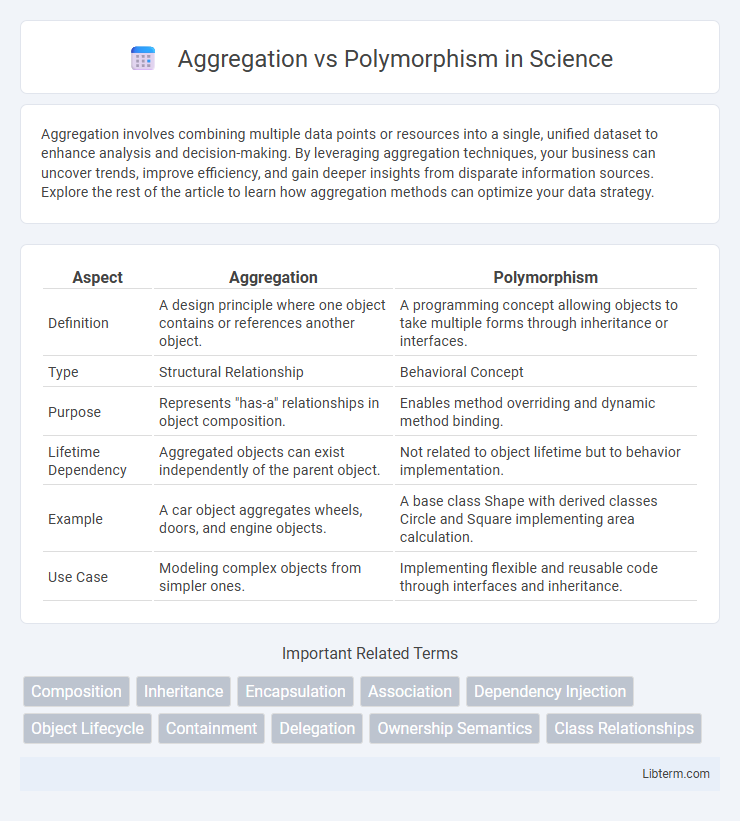Aggregation involves combining multiple data points or resources into a single, unified dataset to enhance analysis and decision-making. By leveraging aggregation techniques, your business can uncover trends, improve efficiency, and gain deeper insights from disparate information sources. Explore the rest of the article to learn how aggregation methods can optimize your data strategy.
Table of Comparison
| Aspect | Aggregation | Polymorphism |
|---|---|---|
| Definition | A design principle where one object contains or references another object. | A programming concept allowing objects to take multiple forms through inheritance or interfaces. |
| Type | Structural Relationship | Behavioral Concept |
| Purpose | Represents "has-a" relationships in object composition. | Enables method overriding and dynamic method binding. |
| Lifetime Dependency | Aggregated objects can exist independently of the parent object. | Not related to object lifetime but to behavior implementation. |
| Example | A car object aggregates wheels, doors, and engine objects. | A base class Shape with derived classes Circle and Square implementing area calculation. |
| Use Case | Modeling complex objects from simpler ones. | Implementing flexible and reusable code through interfaces and inheritance. |
Introduction to Aggregation and Polymorphism
Aggregation is a fundamental object-oriented programming concept where a class contains references to objects of other classes, establishing a "has-a" relationship that promotes code reusability and modular design. Polymorphism enables objects of different classes to be treated as instances of a common superclass through method overriding, supporting dynamic method resolution and flexible code execution. Both aggregation and polymorphism enhance software design by fostering modularity, extensibility, and maintainability in complex applications.
Defining Aggregation in Object-Oriented Programming
Aggregation in object-oriented programming is a specialized form of association that represents a "has-a" relationship between objects, where one object contains or is composed of other objects without owning their lifecycle. This relationship implies that the contained objects can exist independently of the container object, enabling modular and reusable code structures. Aggregation contrasts with composition by allowing shared ownership and looser coupling between the aggregate and its constituent parts.
Understanding Polymorphism: Concepts and Types
Polymorphism enables objects of different classes to be treated as instances of a common superclass through method overriding and interface implementation, enhancing code flexibility and scalability. The primary types of polymorphism include compile-time polymorphism, achieved via method overloading and operator overloading, and runtime polymorphism, realized through method overriding in inheritance hierarchies. Understanding these concepts is crucial for designing robust object-oriented systems that promote code reuse and dynamic behavior.
Key Differences Between Aggregation and Polymorphism
Aggregation represents a "has-a" relationship where one class contains references to objects of another class, emphasizing object composition and reuse. Polymorphism enables objects of different classes to be treated as instances of a common superclass, supporting dynamic method overriding and behavior flexibility. Aggregation focuses on object relationships and structure, while polymorphism centers on interface compatibility and runtime method resolution.
Practical Examples of Aggregation
Aggregation represents a "has-a" relationship where one object contains or is composed of other objects, such as a library class containing multiple book objects. In practical examples, an online shopping cart aggregates multiple product items without owning their lifecycle, allowing products to exist independently. This contrasts with polymorphism, which enables objects of different classes to be treated through a common interface, focusing on dynamic method dispatch rather than object composition.
Practical Applications of Polymorphism
Polymorphism enables objects of different classes to be treated as instances of a common superclass, allowing methods to be used interchangeably and enhancing code flexibility in software development. Practical applications include implementing dynamic method dispatch in object-oriented programming languages like Java and C++, enabling runtime behavior selection based on object types. This approach streamlines code maintenance and supports scalable designs in systems such as GUI frameworks, payment processing, and game development.
Aggregation vs Polymorphism: Use Case Scenarios
Aggregation is ideal for use cases requiring a "has-a" relationship where objects maintain independent lifecycles, such as a library system where a library aggregates books without owning them entirely. Polymorphism suits scenarios demanding interchangeable behavior across related classes, like a payment gateway processing various payment methods through a common interface. Combining aggregation with polymorphism allows flexible object composition while enabling dynamic method implementation tailored to specific use cases.
Advantages and Disadvantages of Aggregation
Aggregation offers advantages such as enhanced modularity by allowing objects to be assembled from other objects without owning their lifecycle, promoting code reuse and easier maintenance. Its disadvantage lies in potential complexity when managing object relationships, as changes in aggregated objects might not automatically propagate, requiring careful handling of dependencies. Unlike polymorphism, which provides flexibility through a unified interface for many object types, aggregation focuses on structural relationships but may lack dynamic behavior adaptability.
Benefits and Limitations of Polymorphism
Polymorphism enhances code flexibility by allowing objects of different classes to be treated through a common interface, promoting code reusability and easier maintenance. It supports runtime method binding, enabling dynamic behavior based on object types, but can introduce performance overhead due to virtual method calls. Despite improving extensibility, polymorphism can complicate debugging and increase system complexity when overused or improperly implemented.
Choosing Between Aggregation and Polymorphism: Best Practices
Choosing between aggregation and polymorphism depends on the design goals and the relationship between objects; aggregation is best for representing "has-a" relationships where one object contains or references another, maintaining loose coupling and enabling reusability. Polymorphism excels in scenarios requiring interchangeable objects sharing a common interface or superclass, facilitating dynamic behavior and adherence to the Open/Closed Principle. Best practices emphasize using aggregation to compose complex objects while leveraging polymorphism to implement flexible and extensible behavior patterns within class hierarchies.
Aggregation Infographic

 libterm.com
libterm.com